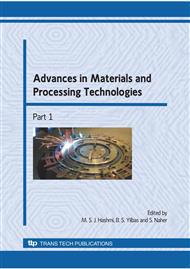p.190
p.198
p.206
p.214
p.222
p.230
p.237
p.244
p.250
Numerical Simulation and Experimental Study on Corrugated Waist Rail with Universal Rolling
Abstract:
The rolling process of corrugated waist rail is simulated by explicit dynamic FEM. The influence of rolling velocity, reduction and the initial thickness on the rolling force is analyzed. The rolling corrugated waist rail is experimented on the three-stands universal mill of Yanshan University. At the same rolling condition, the rolling force obtained from experiment is coincident with the simulation, this proves the theory analysis is correct. Therefore, the rolling parameters obtained from simulation can be instructive to the production site.
Info:
Periodical:
Pages:
222-229
Citation:
Online since:
December 2009
Authors:
Price:
Сopyright:
© 2010 Trans Tech Publications Ltd. All Rights Reserved
Share:
Citation:


